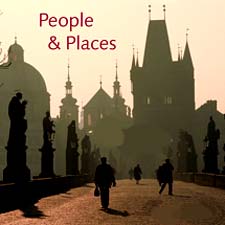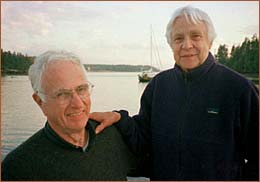|
FRESH STUFF DAILY |
|
|
||
|
|
||
|
|
||
|
SEE ALL SIGNED BOOKS by J. Dennis Robinson click here |
||
Mix an architecture professor from MIT and a psychiatry professor from Harvard and what do you get? You get a ground breaking book about how people react to the places they live. You also get a retired New Hampshire couple whose book will "touch the hearts and minds" or readers according to the NY Times Book Review.
People & Places: An interview with the authorsof People and Places Can you describe this book for us in one sentence? Marty: People and Places explors how we react to places and suggests that our reactions stem from very early childhood needs. Jack: The profound importance that places have for people whether they realize it or not.
Marty: Jack was teaching at MIT in the department of architecture. He wanted his students to have a different relationship with him than the usual one -- where the student learned from the Master. To get them to think independently he asked them to think about a place that was special for them and to share their findings with their fellow students. At the time I was working in child psychiatry. One evening he brought the class to our home and asked me to comment on the "analogues ", which is what we called the students’ descriptions of the places that they cared about. The students had beautiful visual presentations but they found it hard to talk about. I felt it was because of very early subconscious feelings. That started Jack and I talking and while we didn’t actually think of a book at that point, we began to explore the relationships between our early needs and our reactions to places. This in turn led us to set up a seminar where architects and psychiatrists and psychologists got together to explore and comment on our findings. When did you first realize that this was a groundbreaking idea? Marty: We had trouble finding any written material on the connections that we were making. There were three books that were important to us; Kevin Lynch’s The Image of the City, Bloomer and Moore’s Body, Memory and Architecture, and Bachelard’s The Poetics of Space. Critics like The New York Times, Muschamp and The Boston Globe’s Campbell often touched on some of our conclusions. There are others, but none made quite the approach that we did—which stemmed from our discussions. What was it like to collaborate with your spouse, especially given that you are both from different fields of study? Jack: As an architect in practice, I found myself every so often turning to Marty for opinion about a place I was designing for her psychological sense for it: Was it too big? Too complex? Too something? Her answers were always insightful and the exchanges enjoyable! Marty: We had great fun collaborating. We helped each other write -- neither of us have written much and never before together. My only experience in writing was writing diagnostic reports, which turned out to be helpful. Jack’s experience was in teaching and giving lectures, which was very different but added a great deal. How do you think this idea will be received? Do you expect it will influence change within your academic fields? Jack: With respect to architecture, it is hard to say. There are many diverse routes into architecture. Certainly not all, maybe only a few, will be open at first to these ideas. There is a part of the field, which makes use of the tools of user consultancy with respect to place design for the satisfaction of the places’ users, even though many do not. User consultancy was first introduced in our field in the early 60’s by my firm. The architectural schools may be the most likely source of change in the practices of architecture, but some firms may also be open to it! Marty: We hope it will open up a dialogue between the fields. I think that many architects see themselves as "artists" and are not working from a base of what motivates people to connect to places. I hope it will open up new ways of thinking about how they design. Psychiatrists and psychologists and to a lesser degree social workers are used to working on a one to one basis, but it is our hope that they will think of their clients in a new light and realize that places are vital to people, and that their input is needed by the architectural community. What was the most challenging part of writing People & Places? Marty: Writing down our ideas and getting images to match the content was challenging. Jack: First in finding time to do it! After full career lives for both of us, and parenting three energetic kids, we finally found ourselves in Tamworth, NH with time to write the book! Second, in the exploring about how we were to think about people in this project, Marty came up with the idea that Eric Erikson’s work in describing the ages of man might serve us in thinking about people and places. Through that lens we could focus on the differing experiences we have in each age, starting in the womb and running to the end of life. This was a great conceptual step for us! ABOUT THE AUTHORS John R. Myer was born in Boston, Massachusetts. After serving in the Air Force, he entered Massachusetts Institute of Technology, graduating in 1952 with a bachelor's degree in architecture. From 1952 to 1954 John and his wife Margaret, studied and worked in Italy. Upon returning to the United States, John combined the starting of his own firm with the teaching of architecture at MIT. His firm eventually became Arrowstreet Inc., and in time he became department head of architecture at MIT. Notable among his many buildings are the Boston Architectural Center and the Library at Marlboro College; John was co-head, with Kevin Lynch of the design team for Boston's Government Center and the Boston waterfront. More recently, he designed the Massachusetts State Archives. Margaret H. Myer was born in New Haven, Connecticut, and graduated from Wellesley College in 1950. She received her master's degree in social work and worked in child psychiatry at Tufts New England Medical Center, where she was Assistant Clinical Professor of Psychiatry. She became a lecturer on psychology at Harvard Medical School while working at Cambridge Hospital and developing a private practice. The Myers retired to New Hampshire in 1996, built a house and barn, and began collaborating on this book. Please visit these SeacoastNH.com ad partners.
News about Portsmouth from Fosters.com |
| Thursday, April 25, 2024 |


|
Copyright ® 1996-2020 SeacoastNH.com. All rights reserved. Privacy Statement
Site maintained by ad-cetera graphics






 Jack: It began in a talk with Michael Pollan about his book A Place of My Own. It occurred to us after that talk that we could write a book about places given all the exchanges we had had in our lives about them. Our ideas on the relationship between place and people had roots farther back. We had received a Fulbright to go to study architecture in Italy. We found ourselves there in Fiesole, outside Florence, at the same time as Kevin Lynch who was there studying the form of cities. An effort, which would result in Lynch’s groundbreaking work called the Image of the City. We found ourselves both collaborating with Kevin in this work, which got us thinking about places and parts of cities. When we returned to Cambridge to practice architecture and teach at MIT, we continued our closeness and friendship with Kevin.
Jack: It began in a talk with Michael Pollan about his book A Place of My Own. It occurred to us after that talk that we could write a book about places given all the exchanges we had had in our lives about them. Our ideas on the relationship between place and people had roots farther back. We had received a Fulbright to go to study architecture in Italy. We found ourselves there in Fiesole, outside Florence, at the same time as Kevin Lynch who was there studying the form of cities. An effort, which would result in Lynch’s groundbreaking work called the Image of the City. We found ourselves both collaborating with Kevin in this work, which got us thinking about places and parts of cities. When we returned to Cambridge to practice architecture and teach at MIT, we continued our closeness and friendship with Kevin.














